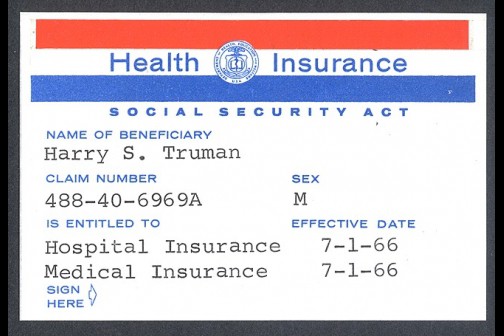Celebrating Medicare’s Anniversary
 Before the enactment of Medicare, 48 years ago, only 50% of seniors had health insurance and 35% lived in poverty. That was a time when even a minor illness or injury could bankrupt older Americans and their families. Fast forward to 2013 and nearly 50 million Americans are receiving guaranteed health care benefits through the Medicare program regardless of their medical condition or income.
Before the enactment of Medicare, 48 years ago, only 50% of seniors had health insurance and 35% lived in poverty. That was a time when even a minor illness or injury could bankrupt older Americans and their families. Fast forward to 2013 and nearly 50 million Americans are receiving guaranteed health care benefits through the Medicare program regardless of their medical condition or income.
Protecting this lifeline benefit for the future is why National Committee to Preserve Social Security and Medicare activists in 50+ cities and towns across the country, have converged on more than 40 Congressional district offices and every single Congressional office on Capitol Hill to deliver Medicare anniversary signs. We’ve asked members of Congress to display the sign on their office door this week to show their support for protecting Medicare’s life-saving benefits.
We’ve also given each Member a special anniversary card reminding them of what millions of average American families already know…exactly why we love Medicare.
Top Ten Reasons Americans LOVE Medicare
1. Medicare provides comprehensive health care coverage for seniors. Since its creation in 1965, Medicare has provided universal health care to millions of seniors.
2. Without Medicare, America’s seniors would lack insurance coverage due to high costs or preexisting conditions. Before Medicare, more than half of seniors lacked hospital insurance. Today, virtually all people ages 65 and over are covered by Medicare.
3. Medicare provides free preventive health screenings. Seniors do not have to pay for Mammograms, Diabetes or Cancer screenings thanks to new provisions in the Affordable Care Act.
4. Medicare provides 36 million seniors prescription drug coverage through Part D. The program will be even better when, thanks to the ACA, the Part D coverage gap known as the “donut hole” will be phased out by 2020.
5. 9 million disabled Americans receiving Social Security benefits also receive health coverage through Medicare.
6. Medicare’s costs rise slower than private insurance. Medicare spending per beneficiary rose more than 400 percent from 1969 to 2009 but inflation-adjusted premiums on private health insurance rose more than 700 percent.
7. Medicare is efficient. Only 1% of traditional Medicare’s spending is overhead compared to 9% for private insurance and 6% for privatized Medicare.
8. Medicare saves lives. Research shows Medicare patients are 20 percent less likely to die within a week of hospital admission than slightly younger patients who do not yet qualify for government insurance.
9. We earn our Medicare coverage. Medicare isn’t welfare. American workers’ payroll taxes fund hospital, skilled nursing, home health and hospice care and premiums cover a portion of the costs for physician visits, outpatient visits and preventive services.
10. Medicare is a social insurance program that works. Perhaps one of the biggest reasons why Medicare is universally cherished is that in return for the contributions we make during our working years, we receive guaranteed health benefits.



You can find all of our Medicare anniversary celebration material on our Anniversary website here.
Seniors to Ask Congress “Do You Really Support Medicare?”
Medicare’s 48th anniversary is next week on July 30th. NCPSSM activists will mark the event by visiting Congressional offices in 50+ cities and towns across the country. Advocates will also be delivering Medicare anniversary signs to every House and Senate office on Capitol Hill.
Members will be asked to display the sign on their office door on July 30th to show their support for Medicare. Included in the delivery will be special cards listing the National Committee’s Top 10 reasons why Americans love Medicare.
“In spite of Medicare’s success in keeping America’s seniors healthy and out of poverty, Medicare’s guaranteed coverage is under nearly constant attack in Washington. The budget plan passed in the House would end traditional Medicare, privatize it and leave seniors on their own to negotiate with private insurance companies. It would require seniors to pay $6,000 more each year for fewer benefits, making it harder to choose their own doctors while also giving the wealthiest Americans a massive tax break. Too many Members of Congress who’ve advocated the dismantling of Medicare camouflage their plans with promises to “save” the program. However, the American people know you don’t have to destroy Medicare to strengthen it. That’s the message our activists are delivering directly to Congress on this 48th anniversary.”…Max Richtman, NCPSSM President/CEO
Let’s see how many join our celebration and proudly display their pledge to support Medicare not cut it.



House GOP Plan Shifts Medicare Costs to Seniors
House Republicans on the Ways & Means Committee have released their plans for Medicare. This is the second proposal offering benefit cuts and/or cost shifting for seniors from the Committee, following release of the GOP’s Social Security plan earlier this month:
Congressional Quarterly details their draft legislation:
“The biggest direct change for beneficiaries would be the higher premiums for Parts B and D based on a beneficiary’s income, beginning in 2017. Although beneficiaries with annual individual incomes of $85,000 or more currently pay higher monthly premiums, the draft bill would increase the amount of premiums and the number of beneficiaries paying the higher amounts.
As Obama proposed in his budget, the draft bill would increase the lowest income-related premium from 35 percent to 40 percent, and increase the premiums for other income brackets, with a cap of 90 percent at the highest tier.
The draft bill would maintain the income thresholds associated with those premiums until 25 percent of beneficiaries are subject to the higher premiums. The change would save $56.3 billion over 10 years, according to the CBO.
The proposal also would apply a $25 increase to the Part B deductible in 2017, 2019, and 2021 for new Medicare beneficiaries. The CBO estimated this would save $3.3 billion over 10 years.
Finally, the proposal would add a new $100 copayment for home health episodes for new beneficiaries beginning in 2017, which the CBO estimated would save $700 million over 10 years.”
While some in Congress, including President Obama, claim further means-testing Medicare only impacts “wealthy” seniors, nothing could be further from the truth. In reality, this means-testing proposal will hit 25% of beneficiaries. A Kaiser Family Foundation study found seniors earning just $47,000 will be targeted with these higher premiums. Since when is a $47,000 annual income considered “wealthy?” In Washington, only when it comes to American seniors apparently. This proposal also does absolutely nothing to tackle the rising cost of health care system-wide. Instead, it just passes those costs directly to seniors.
House Republicans say they want your reaction to their plans to shift costs to seniors. So, let’s give it to them. Email Chairman Dave Camp at:



White House Continues Playing “Let’s Make a Deal” with the GOP on Social Security & Medicare Benefit Cuts



“Gene Sperling, director of the National Economic Council, told reporters that the president “simply is not going to negotiate on the debt limit.” The Hill
Hmmm….Guess what? The White House has been meeting behind closed doors with Republicans ever since then doing exactly that…negotiating with Republicans about which middle-class benefits will be cut in order to head off another GOP led hostage taking over the debt ceiling. Clearly, past is prologue.
Here’s what the National Journal reports today:
“At least a dozen Republican senators are regularly meeting with President Obama’s top aides in an attempt to plot a way forward on the looming fiscal challenges facing leaders this fall, senators involved in the meetings tell National Journal.
The meetings, which began after Obama hosted GOP senators for dinner earlier this year, are the first sign that Democrats and Republicans are in talks to strike a deal that would reduce the deficit and reform entitlements and taxes.
Republicans plan to use the debate over raising the debt limit to force Democrats to cut spending—a negotiation Obama has said he won’t engage in. But these meetings demonstrate that the president is in fact engaging Republicans in a broader discussion about debt and spending.
An administration official said White House aides have made clear to Republicans that the president’s offer from December—including $600 billion in new tax revenue for $400 billion in Medicare and other health care cuts—still stands.
Republicans are open to $600 billion in revenue, Burr said, but want to see it come from a mix of entitlement and tax reform. And the GOP opposes Obama’s $400 billion in Medicare cuts, arguing they want more structural reforms.”
Just in case you’ve forgotten, those “structural reforms” actually end traditional Medicare and put seniors at the mercy of private insurance companies, dramatically increasing their health care costs and limiting their choice of doctors. What Republicans want is passage of the Ryan/GOP budget, which is nothing more than “CouponCare” which gives seniors a coupon to go buy their health coverage from private insurance companies. The American people don’t support “CouponCare” yet the Republicans in the House have introduced this plan three times and clearly hope President Obama will give them what the Senate will not.
And then there’s President Obama’s plan for Social Security and Medicare, which isn’t to be applauded either. He proposes cutting Social Security benefits for current and future retirees, veterans and the disabled plus raising taxes on the middle class through the Chained CPI.
“Cutting benefits by adopting the chained CPI would cut the COLA by 3% for workers retired for ten years and 6% for workers retired for twenty years. This cut targets both current and future retirees. Three years after enactment, this translates to a benefit cut of $130 per year in Social Security benefits for a typical 65 year-old. The cumulative cut for that individual would be $4,631 or more than three months of benefits by age 75. While supporters claim the chained CPI is more accurate; you have to ask yourself, if this chained CPI really is more accurate, then why the need to offer an incremental benefit “bump” to some beneficiaries? The answer is simple. The chained CPI does not accurately measure these groups’ expenses; in fact, it makes most of the same errors as the current formula and adds a few. Adoption of this new formula is really about cutting benefits and raising taxes on average Americans to reduce the deficit.” Max Richtman, NCPSSM President/CEO
In a letter to the White House Max also told the President:
“The ‘chained CPI’ is not a ‘technical tweak,’ and no amount of rationalization can make it so. In reality, the chained CPI is a benefit cut for the oldest and most vulnerable Americans who would be least able to afford it. To offer to trade it away outside the context of a comprehensive Social Security solvency proposal ignores the fact that Social Security does not even belong in this debate because it does not contribute to the deficit. Cutting Social Security benefits to reduce the deficit is unacceptable to the vast majority of Americans across all ages and political affiliation.”
On Medicare, President Obama also supports even further means-testing which will ultimately hit middle-class families, not just “wealthy seniors.”
“Proposals to expand Medicare means testing include increasing income-related premiums under Medicare Parts B and D until 25 percent of beneficiaries are subject to higher premiums. A study from the Kaiser Family Foundation found that this would affect individuals with incomes equivalent to $47,000 for an individual and $94,000 for a couple if fully implemented in 2014 – meaning it would reach many middle-income Americans.”
So, everything old is new again. President Obama is negotiating with the GOP all over again and middle-class benefit cuts are the only thing we know for sure is on the table. You have to wonder, where are Congressional Democrats?!



Understanding the Affordable Care Act
Do you know what the 2014 implementation of ACA will really mean for you? America’s seniors have already started seeing the benefits. Medicare beneficiaries will save, on average, about $4,200 over the next 10 years due to lower drug costs, free preventative services and reductions in the growth of health spending. Since passage of the ACA in 2010, more than 6.3 million people with Medicare saved over $6.1 billion on prescription drugs.
The non-Medicare implementation begins next year and states are getting ready. In New York, the Governor has announced that creation of health exchanges will cut health care premiums in HALF for New York residents. But what will the ACA mean for your family?
The Kaiser Family Foundation, with the help of former ABC anchor Charlie Gibson, explains the law in this new video:


